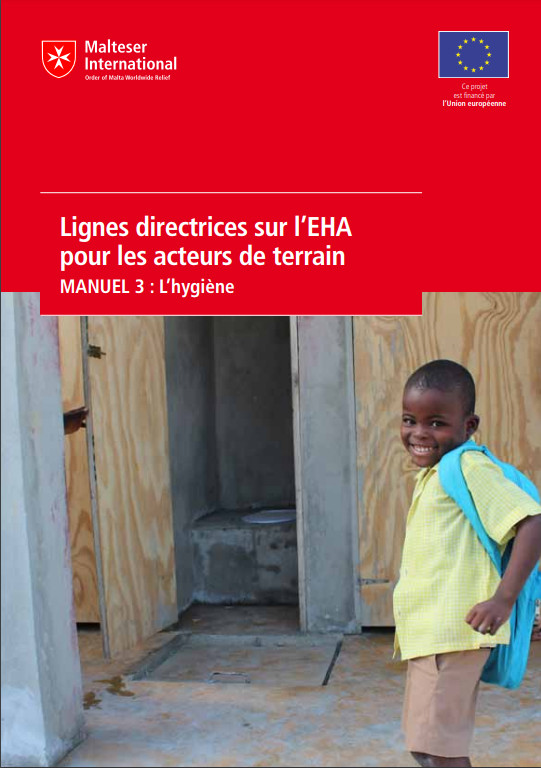Lignes directrices sur l'EHA pour les acteurs de terrain. Manuel 3 : L'hygiène
 |
WASH Guidelines for field practitioners Part 3: Hygiene
guide Oct 2017 ; 150 pages
Ed. Malteser International - Cologne - 2 édition
Downloadable format: PdF
Downloadable from the publisher
 Part 1: Water
Part 1: Water
 Part 2: Sanitation
Abstract:
Part 2: Sanitation
Abstract:Active hygiene promotion, together with an enabling environment and actions that encourage demand for an improved hygiene status have proven to be more effective in achieving better hygiene. This guideline therefore focusses on these key issues that trigger hygiene related behaviour change. Contents:
Section 1: General introduction
Section 2: Global hygiene goals
Section 3: Hygiene context and disease transmission
3.1 Hygiene improvement
3.2 Disease transmission routes
3.2.1 F-diagramme
3.2.2 Infection categories
Section 4: Hygiene perspectives at different operational levels
4.1 Household level
4.2 Community level
4.3 Schools
4.4 Link Malteser International supported social infrastructure development with hygiene promotion
Section 5: Types of hygiene
5.1 Personal hygiene
5.1.1 Handwashing with Soap (HWWS)
5.1.2 Menstrual Hygiene Management (MHM)
5.1.3 Cleaning finger nails
5.1.4 Washing the body
5.1.5 Washing the face
5.1.6 Washing clothes and bedding
5.1.7 Oral hygiene
5.2 Environmental hygiene– around water sources, including drainage
5.3 Domestic hygiene– latrines, house, handwashing facilities, water storage and handling/transport
5.3.1 Latrines and sludge handling
5.3.2 Water storage
5.3.3 Water transport and handling
5.3.4 Domestic waste
5.3.5 Domestic animals
5.4 Food hygiene– storage
Section 6: Behavioural change
6.1 General
6.2 RANAS
6.3 The Health Belief Model (HBM)
6.4 COMBI (Communication for Behavioral Impact)
Section 7: Hygiene behaviour change planning
7.1 Key principles
7.2 Hygiene behaviour transformation programme components
7.3 IEC materials development
7.4 Methodology
7.5 Role of health and hygiene educators
Section 8. Effectiveness of hygiene behaviour change
8.1 Contribution to good health
8.2 Levels of hygiene effectiveness
Section 9: Enabling environment for hygiene promotion
9.1 Soap production options
9.2 Handwashing stations
9.3 Access to water
9.4 Access to sanitation facilities
9.5 Facilities for menstrual hygiene management
Section 10: Hygiene behavioural change in emergencies
Section 11: Hygiene and epidemics
11.1 Cholera prevention
11.2 Other epidemics
Section 12. Cross-cutting issues
12.1 Gender
12.2 Inclusiveness
Section 13. Global annual events
13.1 World Toilet Day
13.2 Global Handwashing Day
13.3 World Water Day
Annexes:
Online References
Abbreviations
Glossary
Keywords: |
hygiene (CI) (DT) (ET) (ope) , menstrual hygiene (CI) (DT) (ET) (ope) , school (CI) (DT) (ET) (ope) |
Publisher/Broadcaster: |
|
Malteser International - Cologne - Germany |
If there is a broken link, we will be pleased to receive a message: communication@pseau.org